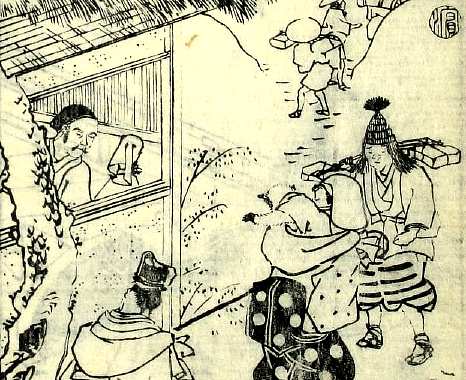Semimaru and the one-two punch
Semimaru died one thousand years ago, but he lives on in the Japanese cultural consciousness as a fierce avatar of ambiguity, a presence whose sheer liminality tears once-happy families apart each new year. Is he a priest, or just bald?* Does the term bōzu include bald non-monastics explicitly, or only metaphorically? When playing bōzu-mekuri with your cousins, these issues are very real.
Fitting then that his poem in the Hyakunin isshu (#10) should also be about a boundary:
これやこの行くも帰るも別れては知るも知らぬも逢坂の関
kore ya kono/ yuku mo kaeru mo/ wakarete wa/ shiru mo shiranu mo/ Ōsaka no seki
This is it/ Goers and comers-back/ Parting and then—/ Known and unknown—/ Meetinghills Gate
Semimaru's work stands out in the HI and indeed among classical Japanese poetry in general: it is crowded, lively, and cheerful where most of its competition is lonely, limpid and melancholy. Which isn't to say it isn't part of the tradition: note that the placename Ōsaka 逢坂 (/afusaka/ at the time, literally "meet - slope", translated "Meetinghills" here) does double duty as the word au (/afu/), "meet," in a very traditional way.
One aggressively modern metaphor for this poem is the binary tree: kore ("this") as the node at the bottom, dividing into branches that end in pairs of opposites: "go" vs "come," (actions) "known" vs "unknown," (states) and "parting" vs "meeting" (interactions). The difficulty here would usually be tying this back into an ending; Semimaru manages it by only providing half of the final pair ("parting..."), dialing up the tension by wedging "known and unknown" in, and then closing the open pair with a line designed to overflow the buffer and construct the final image ("...meeting→hills gate").
To switch metaphors, Semimaru cracks the fundamental meaning-atom "this," then uses the rules of his literary tradition to channel the resultant explosion of dualities back into a singular "that": the gate, an image that combines separation and unity.

In this picture Semimaru is played by Bill Murray.
Early translators of the poem into English emphasized its humanity; adding ideas that in the original were left implicit (travelers, "all") or absent (smiles, resting, "over"):
PORTER (1909)
THE stranger who has travelled far,
The friend with welcome smile,
All sorts of men who come and go
Meet at this mountain stile,—
They meet and rest awhile.
MACCAULEY (1917)
Truly, this is where
Travelers who go or come
Over parting ways,—
Friends or strangers,—all must meet;
'Tis the gate of "Meeting Hill."
Joshua S. MOSTOW's more recent translation in Pictures of the Heart is more conservative content-wise but not as clear structurally. It also retains the worldbuilding initial "this":
This it is! That
going, too, and coming, too
continually separating,
those known and those unknown,
meet at the Barrier of Ōsaka.
The "continually" is in there because he is using a variant which has wakaretsutsu instead of wakarete wa. He also provides a good argument, quoting Susan MATISOFF and ORIGUCHI Shinobu and based on comparisons to other poems beginning kore ya kono, for the -tsutsu version's authenticity. That said, I don't think that "continually" really works in this case: I see the pairs as one-two punches, and it's just awkward to keep the "one" conceptually pressed against the reader's jaw while you're winding up for the "two."
Translating seki as "barrier" instead of "gate" is also of interest. The items in question were indeed intended more as an obstruction to (or at least moderator of) passage than a facilitator of same. "Checkpoint", as in "Charlie," gets pretty close, too, but is a little too modern. Porter's "stile," though, is right out.
![[No-sword]](http://no-sword.jp/images/site/no-sword_banner.jpg)



Carl:
Wait, is that what "limpid" means?